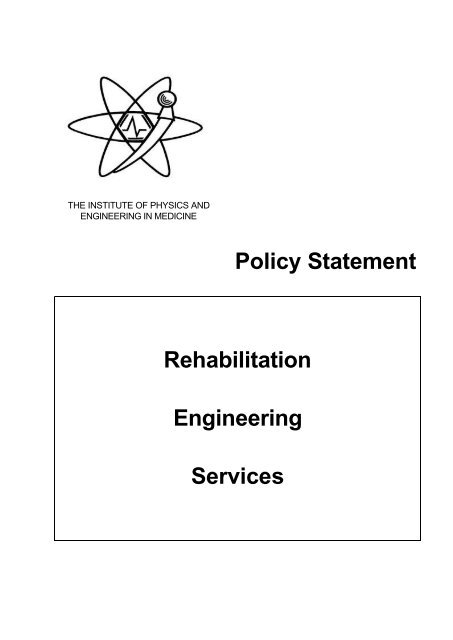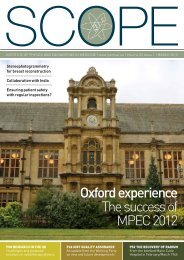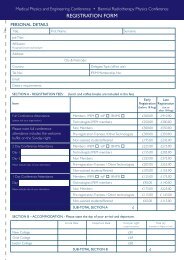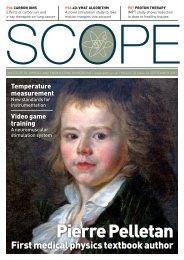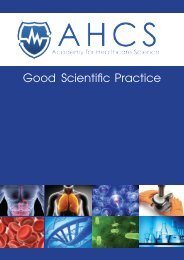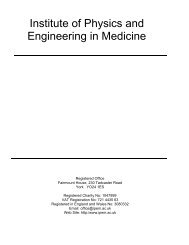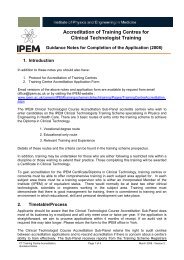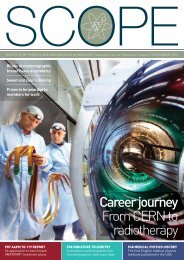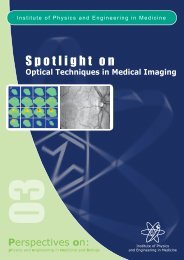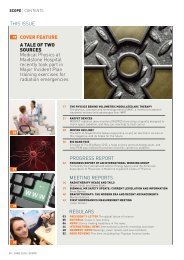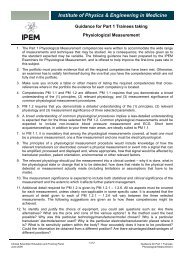here - Institute of Physics and Engineering in Medicine
here - Institute of Physics and Engineering in Medicine
here - Institute of Physics and Engineering in Medicine
You also want an ePaper? Increase the reach of your titles
YUMPU automatically turns print PDFs into web optimized ePapers that Google loves.
THE INSTITUTE OF PHYSICS ANDENGINEERING IN MEDICINEPolicy StatementRehabilitation<strong>Eng<strong>in</strong>eer<strong>in</strong>g</strong>Services
IPEM policy on Rehabilitation <strong>Eng<strong>in</strong>eer<strong>in</strong>g</strong> ServicesProduced by a work<strong>in</strong>g group <strong>of</strong> the Rehabilitation <strong>Eng<strong>in</strong>eer<strong>in</strong>g</strong> <strong>and</strong>Biomechanics Special Interest Group:Alan Turner-Smith, Michael Broadhurst, Simon Fielden, <strong>and</strong> Peter GriffithsINTRODUCTIONRehabilitation <strong>Eng<strong>in</strong>eer<strong>in</strong>g</strong> is the cl<strong>in</strong>ical application <strong>of</strong> eng<strong>in</strong>eer<strong>in</strong>g pr<strong>in</strong>ciples <strong>and</strong>technology <strong>in</strong> the provision <strong>of</strong> services, research, <strong>and</strong> development to meet the needs <strong>of</strong><strong>in</strong>dividuals with disabilities. It <strong>in</strong>volves the reduction <strong>of</strong> environmental barriers, <strong>and</strong>/or t<strong>here</strong>storation or improvement <strong>of</strong> the physical, mental <strong>and</strong> social function <strong>of</strong> a person with adisability.Rehabilitation <strong>Eng<strong>in</strong>eer<strong>in</strong>g</strong> is an important element <strong>of</strong> a comprehensive rehabilitationservice, <strong>and</strong> <strong>in</strong>cludes the follow<strong>in</strong>g services <strong>and</strong> subjects <strong>of</strong> research, design,development, production <strong>and</strong> market<strong>in</strong>g:• Wheeled mobility: chairs <strong>and</strong> special vehicles;• Augmentative <strong>and</strong> Alternative Communication systems;• Assistive devices, for all activities <strong>of</strong> daily liv<strong>in</strong>g <strong>in</strong> domestic, educational, vocational,recreational, social <strong>and</strong> <strong>in</strong>stitutional environments;• Electronic assistive technology, <strong>in</strong>clud<strong>in</strong>g technology access, customised or modifiedcontrols, environmental controls, <strong>and</strong> <strong>in</strong>tegrated systems;• Functional Electrical Stimulation;• Biomechanical analysis <strong>in</strong> rehabilitation;• Specialised orthoses (<strong>in</strong>clud<strong>in</strong>g seat<strong>in</strong>g) <strong>and</strong> prostheses;• Gait analysis.A rehabilitation eng<strong>in</strong>eer<strong>in</strong>g service generally provides a selection <strong>of</strong> these activities. Thisdocument sets out policies designed to promote client-awareness, cl<strong>in</strong>ical effectiveness,<strong>and</strong> the efficient use <strong>of</strong> resources <strong>in</strong> these services.This document conta<strong>in</strong>s various lists that are distillations <strong>of</strong> best practice <strong>and</strong> as suchsubject to cont<strong>in</strong>ual review.STAFFING STRUCTURERehabilitation eng<strong>in</strong>eer<strong>in</strong>g services are provided <strong>in</strong> the NHS through a number <strong>of</strong>establishments, with a variety <strong>of</strong> functions <strong>and</strong> organisational relationships. The activitiesare pursued <strong>in</strong> departments with various titles <strong>in</strong>clud<strong>in</strong>g, most commonly, Cl<strong>in</strong>ical<strong>Eng<strong>in</strong>eer<strong>in</strong>g</strong>, Bioeng<strong>in</strong>eer<strong>in</strong>g, Rehabilitation <strong>Eng<strong>in</strong>eer<strong>in</strong>g</strong>, Medical <strong>Eng<strong>in</strong>eer<strong>in</strong>g</strong>, Medical<strong>Physics</strong>, <strong>and</strong> Disablement Services.The education, tra<strong>in</strong><strong>in</strong>g <strong>and</strong> qualifications <strong>of</strong> eng<strong>in</strong>eer<strong>in</strong>g practitioners are reflected <strong>in</strong> theiremployment grades which, <strong>in</strong> the NHS, <strong>in</strong>cludes Medical Technical Officers (MTOs) <strong>and</strong>Cl<strong>in</strong>ical Scientists/Eng<strong>in</strong>eers 1 .1 The term “rehabilitation eng<strong>in</strong>eer” or “RE” is <strong>of</strong>ten used colloquially to describe a member <strong>of</strong> eng<strong>in</strong>eer<strong>in</strong>gstaff <strong>in</strong> a rehabilitation service. This usage is unfortunate because it does not differentiate between threedist<strong>in</strong>ct levels <strong>of</strong> tra<strong>in</strong><strong>in</strong>g <strong>and</strong> competence. In earlier documents, IPEM has referred to eng<strong>in</strong>eer<strong>in</strong>g staffoperat<strong>in</strong>g <strong>in</strong> a cl<strong>in</strong>ical rehabilitation context as Rehabilitation <strong>Eng<strong>in</strong>eer<strong>in</strong>g</strong> Technician (RET), RehabilitationJune 1999 (Version 3) Policy 008/991
MTOs (or Rehabilitation Technologists) are primarily concerned with the operationalaspects <strong>of</strong> service delivery such as rout<strong>in</strong>e fitt<strong>in</strong>g <strong>and</strong> repair, device manufacture, <strong>and</strong>basic design specification. MTO career progression depends on cont<strong>in</strong>uity, quality, <strong>and</strong>the scope <strong>of</strong> a service. Cl<strong>in</strong>ical Scientists/Eng<strong>in</strong>eers lead the organisational aspects <strong>of</strong>the service <strong>and</strong> may conduct <strong>in</strong>dependent assessment <strong>of</strong> clients. They direct complexissues such as the provision <strong>of</strong> <strong>in</strong>novative solutions for <strong>in</strong>dividual clients, research <strong>and</strong>development, <strong>and</strong> the development <strong>of</strong> new methods <strong>and</strong> scope <strong>of</strong> service provision.A rehabilitation eng<strong>in</strong>eer<strong>in</strong>g service employs a team <strong>of</strong> an appropriate size <strong>and</strong> balance tomeet the needs <strong>of</strong> the specialist service areas it addresses (listed above). The numbers<strong>of</strong> staff <strong>and</strong> their support<strong>in</strong>g resources will be determ<strong>in</strong>ed by the total activity required. Theteam would normally comprise a mix <strong>of</strong> Rehabilitation Technologists (RT) <strong>and</strong> Cl<strong>in</strong>icalScientists/Eng<strong>in</strong>eers (CE).Each rehabilitation eng<strong>in</strong>eer<strong>in</strong>g service should have an identified head <strong>of</strong> departmentresponsible for its proper function<strong>in</strong>g, for sett<strong>in</strong>g its priorities <strong>and</strong> for the quality <strong>of</strong> theservice provided. This will normally be a consultant (C-Grade) or pr<strong>in</strong>cipal grade (B17 <strong>and</strong>above) Cl<strong>in</strong>ical Scientist/Eng<strong>in</strong>eer. W<strong>here</strong> the head <strong>of</strong> the service is not a ConsultantGrade appo<strong>in</strong>tment, the unit should be l<strong>in</strong>ked formally with a larger department/unit headedby a consultant grade Cl<strong>in</strong>ical Scientist/Eng<strong>in</strong>eer with experience <strong>in</strong> rehabilitation ormedical eng<strong>in</strong>eer<strong>in</strong>g. The purpose <strong>of</strong> the l<strong>in</strong>k is to provide pr<strong>of</strong>essional support forassur<strong>in</strong>g service st<strong>and</strong>ards <strong>and</strong> career development.LEGISLATION AND POLICYRehabilitation eng<strong>in</strong>eer<strong>in</strong>g service structure <strong>and</strong> organisation should provide appropriateaccess to relevant documentation. Service policy <strong>and</strong> procedures should ensurecompliance with relevant legislation <strong>and</strong> NHS policies <strong>and</strong> regulations. Information listedbelow is not exhaustive but merely a guide to some <strong>of</strong> the most important legislationpolicies <strong>and</strong> regulations.European DirectivesThe follow<strong>in</strong>g European Directives are directly relevant to rehabilitation equipment. EachEuropean Directive has been implemented <strong>in</strong> the UK by the Regulations listed below:European DirectiveUK RegulationThe Medical Devices Directive - 93/42/EEC The Medical Devices Regulations 1994The Low Voltage Directive - 73/23/EEC The Electrical Equipment (Safety) Regulations 1994The Electromagnetic Compatibility Directive -89/336/EEC (& 92/31/EEC, 91/263/EEC)The Electromagnetic Compatibility Regulations 1992Eng<strong>in</strong>eer (RE), <strong>and</strong> Cl<strong>in</strong>ical Eng<strong>in</strong>eer (CE). These corresponded to the <strong>Eng<strong>in</strong>eer<strong>in</strong>g</strong> Council def<strong>in</strong>itions for<strong>Eng<strong>in</strong>eer<strong>in</strong>g</strong> Technician (Eng. Tech.), Incorporated Eng<strong>in</strong>eer (I. Eng.), <strong>and</strong> Chartered Eng<strong>in</strong>eer (C.Eng.)respectively. This usage has not been strictly ad<strong>here</strong>d to <strong>in</strong> the Health Service <strong>and</strong> so, to avoid confusion,this document refers only to three employment grades: Technologist (usually an Incorporated Eng<strong>in</strong>eer or<strong>Eng<strong>in</strong>eer<strong>in</strong>g</strong> Technician, depend<strong>in</strong>g on duties), Cl<strong>in</strong>ical Scientist/Eng<strong>in</strong>eer (usually a Chartered Eng<strong>in</strong>eer)<strong>and</strong> Consultant grade Cl<strong>in</strong>ical Scientist/Eng<strong>in</strong>eer (head<strong>in</strong>g a small department or major section <strong>in</strong> a largedepartment).June 1999 (Version 3) Policy 008/992
The NHS Executive issues letters detail<strong>in</strong>g NHS provider actions regard<strong>in</strong>g specificissues. EL(98)5 details Medical Devices Directive guidel<strong>in</strong>es for NHS <strong>in</strong>-housemanufactur<strong>in</strong>g.The NHS Executive issues Health Service Circulars (HSCs) detail<strong>in</strong>g advice or actionregard<strong>in</strong>g specific issues <strong>in</strong> the NHS. These may be aimed at Health Providers <strong>and</strong>Rehabilitation <strong>Eng<strong>in</strong>eer<strong>in</strong>g</strong> Services should have access to relevant HSCs.Local procedures should be <strong>in</strong> place to ensure that Rehabilitation <strong>Eng<strong>in</strong>eer<strong>in</strong>g</strong> Servicesare aware <strong>of</strong> <strong>and</strong> can operate to st<strong>and</strong>ards such as the Patients’ Charter.Technology St<strong>and</strong>ardsConformity with European Directives <strong>and</strong> UK regulations <strong>in</strong>volves compliance withappropriate st<strong>and</strong>ards. Some <strong>of</strong> the key st<strong>and</strong>ards are listed below; the list is notexhaustive.BS EN 29999 – Technical Aids For Disabled Persons – ClassificationBS EN ISO 9000 – Quality AssuranceBS EN 46000 – Application Of ISO 9000 to Medical ManufactureBS EN ISO 7250 – Basic Human Body Measurements for Technological DesignBS 7313 ISO 8549 – Prosthetics <strong>and</strong> OrthoticsBS EN 55011 – Test Limits And Methods For EMC MeasurementBS EN 60529 – Degrees Of Protection Provided By EnclosuresBS EN 1441 – Medical Devices, Risk AnalysisBS EN ISO 7176 – WheelchairsBS EN 60601 – Medical Electrical EquipmentBS 2574 – Lower Limb OrthosesBS 308 – <strong>Eng<strong>in</strong>eer<strong>in</strong>g</strong> Draw<strong>in</strong>g PracticeService St<strong>and</strong>ardsService st<strong>and</strong>ards are the subject <strong>of</strong> constant re-assessment. Documents that have beenuseful <strong>in</strong> sett<strong>in</strong>g st<strong>and</strong>ards <strong>in</strong> rehabilitation eng<strong>in</strong>eer<strong>in</strong>g services are listed <strong>in</strong> the follow<strong>in</strong>gbibliography, which is not exhaustive.• RESMaG <strong>and</strong> IPEM Rehabilitation <strong>Eng<strong>in</strong>eer<strong>in</strong>g</strong> Services: Functions, Competencies, <strong>and</strong>Resources. Centre <strong>of</strong> Rehabilitation <strong>Eng<strong>in</strong>eer<strong>in</strong>g</strong>, K<strong>in</strong>g’s College London, May 1996.• K<strong>in</strong>g’s Fund Manual on Organisational Audit - Medical <strong>Physics</strong> <strong>and</strong> Biomedical <strong>Eng<strong>in</strong>eer<strong>in</strong>g</strong>Service. (Rehabilitation <strong>Eng<strong>in</strong>eer<strong>in</strong>g</strong>).• DoH Health Notice HN(90)18 Scientific <strong>and</strong> Technical Services.• ISO 9000 (Quality Management) documents.• DoH Technician Tra<strong>in</strong><strong>in</strong>g Programme First-Stage Technician <strong>in</strong> Rehabilitation <strong>Eng<strong>in</strong>eer<strong>in</strong>g</strong>.DoH, 1991.• DoH Technician Tra<strong>in</strong><strong>in</strong>g Programme Rehabilitation <strong>Eng<strong>in</strong>eer<strong>in</strong>g</strong> (Advanced). DoH, 1992.• The <strong>Eng<strong>in</strong>eer<strong>in</strong>g</strong> Council Code <strong>and</strong> Rules <strong>of</strong> Conduct <strong>and</strong> their series Code <strong>of</strong> Pr<strong>of</strong>essionalPractice.• The <strong>Eng<strong>in</strong>eer<strong>in</strong>g</strong> Council St<strong>and</strong>ards <strong>and</strong> Routes to Registration, (SARTOR), 3rd Edition1998.• IPEM Articles <strong>of</strong> Association – Pr<strong>of</strong>essional Conduct.• IPEM Tra<strong>in</strong><strong>in</strong>g Scheme for Physical Scientists <strong>in</strong> Health Care – Rehabilitation <strong>Eng<strong>in</strong>eer<strong>in</strong>g</strong>.June 1999 (Version 3) Policy 008/994
FUNCTIONSThe role <strong>of</strong> a rehabilitation eng<strong>in</strong>eer<strong>in</strong>g department is to provide pr<strong>of</strong>essional eng<strong>in</strong>eer<strong>in</strong>gsupport to clients, both <strong>in</strong> hospitals <strong>and</strong> <strong>in</strong> the community. It should act as part <strong>of</strong> amultidiscipl<strong>in</strong>ary healthcare team, provid<strong>in</strong>g specialist eng<strong>in</strong>eer<strong>in</strong>g knowledge <strong>and</strong> skills tocl<strong>in</strong>ical staff <strong>and</strong> clients, as <strong>in</strong>creas<strong>in</strong>gly complex technology for assessment <strong>and</strong>assistance becomes available to them. A department should be flexible <strong>and</strong> responsive tochang<strong>in</strong>g local dem<strong>and</strong>s but it should employ a mix <strong>of</strong> pr<strong>of</strong>essional eng<strong>in</strong>eers <strong>and</strong>technologists able to perform the follow<strong>in</strong>g basic functions.1) Assessment <strong>of</strong> client needs, either <strong>in</strong>dependently as a Cl<strong>in</strong>ical Scientist or with<strong>in</strong> amulti-discipl<strong>in</strong>ary team, <strong>in</strong> order to meet agreed goals.2) Assessment <strong>of</strong> client function, either <strong>in</strong>dependently as a Cl<strong>in</strong>ical Scientist or with<strong>in</strong>a multi-discipl<strong>in</strong>ary team; use <strong>of</strong> <strong>in</strong>strumentation to provide quantitativeassessment; <strong>and</strong> <strong>in</strong>terpretation <strong>of</strong> data acquired.3) Identification <strong>of</strong> commercial solutions. Design <strong>and</strong> development <strong>of</strong> novel, costeffectivesolutions w<strong>here</strong> commercial options are not available.4) Customisation, <strong>in</strong>tegration <strong>and</strong> <strong>in</strong>stallation <strong>of</strong> commercially available equipment tomeet specific client needs.5) Analysis <strong>of</strong> risks associated with the use, provision, or development <strong>of</strong> technology.6) <strong>Eng<strong>in</strong>eer<strong>in</strong>g</strong> support to purchas<strong>in</strong>g decisions through creation <strong>of</strong> detailedspecifications prior to contract, monitor<strong>in</strong>g contract progress, <strong>and</strong> acceptancetest<strong>in</strong>g at delivery.7) Ma<strong>in</strong>tenance <strong>and</strong>/or refurbishment <strong>of</strong> equipment <strong>in</strong> <strong>in</strong>stitutions <strong>and</strong> the community,either directly or through contractors.8) Organised retention <strong>of</strong> records <strong>and</strong> data.9) Tra<strong>in</strong><strong>in</strong>g or teach<strong>in</strong>g <strong>of</strong> cl<strong>in</strong>ical staff <strong>in</strong> eng<strong>in</strong>eer<strong>in</strong>g matters, such as basiceng<strong>in</strong>eer<strong>in</strong>g pr<strong>in</strong>ciples, use <strong>of</strong> equipment, new legislation, <strong>and</strong> developments <strong>in</strong>technology.10) Contribution to the wider development <strong>of</strong> rehabilitation eng<strong>in</strong>eer<strong>in</strong>g through activeparticipation on pr<strong>of</strong>essional bodies, research, <strong>and</strong> the dissem<strong>in</strong>ation <strong>of</strong><strong>in</strong>formation by published materials <strong>and</strong> scientific meet<strong>in</strong>gs.A department should carry out its functions <strong>in</strong> l<strong>in</strong>e with the latest best practice <strong>and</strong> <strong>in</strong>compliance with current legislation <strong>and</strong> relevant national <strong>and</strong> <strong>in</strong>ternational st<strong>and</strong>ards (seeLegislation <strong>and</strong> Policy). Staff should be tra<strong>in</strong>ed to appropriate pr<strong>of</strong>essional levels <strong>and</strong>tra<strong>in</strong><strong>in</strong>g should be cont<strong>in</strong>uous to keep pace with technological developments.COMPETENCEThe follow<strong>in</strong>g describes the tra<strong>in</strong><strong>in</strong>g process for specialist staff <strong>in</strong> rehabilitationeng<strong>in</strong>eer<strong>in</strong>g services <strong>and</strong> key elements for their career progression. They are current atthe time <strong>of</strong> publication <strong>and</strong> subject to regular review. Readers should contact IPEM for thelatest <strong>in</strong>formation (www.ipem.org).Cl<strong>in</strong>ical Scientists/Eng<strong>in</strong>eersGrade A Tra<strong>in</strong><strong>in</strong>g SchemeIPEM has <strong>in</strong>troduced <strong>and</strong> developed a basic tra<strong>in</strong><strong>in</strong>g scheme for new entrants <strong>in</strong>to thepr<strong>of</strong>ession. Follow<strong>in</strong>g graduation from a first degree course approved by the <strong>Eng<strong>in</strong>eer<strong>in</strong>g</strong>Council or the <strong>Institute</strong> <strong>of</strong> <strong>Physics</strong>, tra<strong>in</strong>ees follow a two year structured tra<strong>in</strong><strong>in</strong>g programmeJune 1999 (Version 3) Policy 008/995
compris<strong>in</strong>g an MSc accredited by IPEM <strong>and</strong> competence based tra<strong>in</strong><strong>in</strong>g <strong>in</strong> three majorsubject areas, at a tra<strong>in</strong><strong>in</strong>g centre accredited by the IPEM. At the end <strong>of</strong> the programmetra<strong>in</strong>ees submit a portfolio <strong>of</strong> their work <strong>and</strong> are assessed aga<strong>in</strong>st a published list <strong>of</strong>competencies <strong>in</strong> each subject. Successful completion results <strong>in</strong> the award <strong>of</strong> thePostgraduate Diploma <strong>of</strong> IPEM.Subject areas relevant to Rehabilitation <strong>Eng<strong>in</strong>eer<strong>in</strong>g</strong> <strong>in</strong>clude Rehabilitation <strong>Eng<strong>in</strong>eer<strong>in</strong>g</strong>(Mobility <strong>and</strong> Posture), Rehabilitation <strong>Eng<strong>in</strong>eer<strong>in</strong>g</strong> (Sensory <strong>and</strong> Communication), Medical<strong>Eng<strong>in</strong>eer<strong>in</strong>g</strong> (Design <strong>and</strong> Development), Medical Electronics, Physiological Measurement<strong>and</strong> Information Management <strong>and</strong> Technology. Competencies <strong>in</strong> Biomechanical<strong>Eng<strong>in</strong>eer<strong>in</strong>g</strong>, <strong>in</strong>clud<strong>in</strong>g gait analysis, are also be<strong>in</strong>g developed.Grade BThis is the ma<strong>in</strong> career grade for cl<strong>in</strong>ical eng<strong>in</strong>eers <strong>and</strong> cl<strong>in</strong>ical scientists entry be<strong>in</strong>gga<strong>in</strong>ed through the Grade A tra<strong>in</strong><strong>in</strong>g scheme (although not exclusively). Dur<strong>in</strong>g the first fouryears on the grade, the tra<strong>in</strong>ee follows a Programme <strong>of</strong> Advanced Tra<strong>in</strong><strong>in</strong>g <strong>and</strong>Responsibility (PATR), usually <strong>in</strong> one <strong>of</strong> the major subject areas, lead<strong>in</strong>g to C.Eng. <strong>and</strong>MIPEM. This programme must be submitted for approval by IPEM follow<strong>in</strong>g which anexternal assessor is appo<strong>in</strong>ted to monitor <strong>and</strong> assess the breadth <strong>and</strong> depth <strong>of</strong> tra<strong>in</strong><strong>in</strong>g.After two years, hav<strong>in</strong>g reached the appropriate st<strong>and</strong>ard, the tra<strong>in</strong>ee can apply for entryonto the Register <strong>of</strong> Cl<strong>in</strong>ical Scientists. This is a statutory requirement. Only those nameson the statutory register will be able to practice with the title Cl<strong>in</strong>ical Scientist/Eng<strong>in</strong>eer.Entry onto the Register removes the requirement for direct supervision <strong>and</strong> allows thecl<strong>in</strong>ical eng<strong>in</strong>eer to take <strong>in</strong>creas<strong>in</strong>g responsibility for their work.Follow<strong>in</strong>g a m<strong>in</strong>imum period <strong>of</strong> two years’ responsible experience the Cl<strong>in</strong>ical Eng<strong>in</strong>eercan apply for registration as a Chartered Eng<strong>in</strong>eer <strong>and</strong> Corporate Membership <strong>of</strong> IPEM.Simultaneous assessment is by <strong>in</strong>terview follow<strong>in</strong>g submission <strong>of</strong> a portfolio summaris<strong>in</strong>gthe experience ga<strong>in</strong>ed <strong>and</strong> the level <strong>of</strong> responsibility taken.Higher Grade B <strong>and</strong> Grade CCEng <strong>and</strong> MIPEM confer <strong>in</strong>dependent practitioner status <strong>and</strong> will be a requirement forappo<strong>in</strong>tment to senior posts such as Heads <strong>of</strong> Departments.Cont<strong>in</strong>u<strong>in</strong>g Pr<strong>of</strong>essional DevelopmentCPD will be a statutory requirement to ma<strong>in</strong>ta<strong>in</strong> the level <strong>of</strong> competence dem<strong>and</strong>ed forstate registration. However, all staff will be expected to demonstrate a level <strong>of</strong> CPDappropriate to their grade that will be central to their career progression.Tra<strong>in</strong><strong>in</strong>g <strong>of</strong> TechnologistsThe tra<strong>in</strong><strong>in</strong>g <strong>of</strong> Cl<strong>in</strong>ical Technologists <strong>in</strong> Rehabilitation <strong>Eng<strong>in</strong>eer<strong>in</strong>g</strong> is currently less welldef<strong>in</strong>ed but the policy <strong>of</strong> IPEM is to develop a Programme <strong>of</strong> Structured Tra<strong>in</strong><strong>in</strong>g <strong>and</strong>Responsibility along similar l<strong>in</strong>es to those for Cl<strong>in</strong>ical Eng<strong>in</strong>eers. Entry <strong>in</strong>to the lower MTOgrades will be via an HNC or vocational degree <strong>in</strong> a relevant subject followed by a period<strong>of</strong> <strong>in</strong>-service tra<strong>in</strong><strong>in</strong>g to ensure competence <strong>in</strong> the particular ma<strong>in</strong> subject area before entryonto a statutory register. The latter will be achieved through new legislation. Follow<strong>in</strong>g atleast two years experience, the “registered” Cl<strong>in</strong>ical Technologist may apply for IEng status<strong>and</strong> Incorporated Membership <strong>of</strong> IPEM. These will become <strong>in</strong>creas<strong>in</strong>gly important forappo<strong>in</strong>tment to higher grade posts.June 1999 (Version 3) Policy 008/996
The objects for which the <strong>Institute</strong> is established are to promote for the publicbenefit the advancement <strong>of</strong> physics <strong>and</strong> eng<strong>in</strong>eer<strong>in</strong>g applied to medic<strong>in</strong>e <strong>and</strong>biology <strong>and</strong> to advance public education <strong>in</strong> the field.Further copies <strong>of</strong> this statement may be obta<strong>in</strong>ed from the Head Office <strong>of</strong> the IPEM at thefollow<strong>in</strong>g address:The <strong>Institute</strong> <strong>of</strong> <strong>Physics</strong> <strong>and</strong> <strong>Eng<strong>in</strong>eer<strong>in</strong>g</strong> <strong>in</strong> Medic<strong>in</strong>eFairmount House,230 Tadcaster RoadYork Y024 1ESTelephone: (01904) 610821Fax: (01904) 612279e-mail: policy@ipem.org.ukOther policy statements concern<strong>in</strong>g services carried out by Cl<strong>in</strong>ical Scientists employed <strong>in</strong>Health Care are available from the above address.June 1999 (Version 3) Policy 008/997


